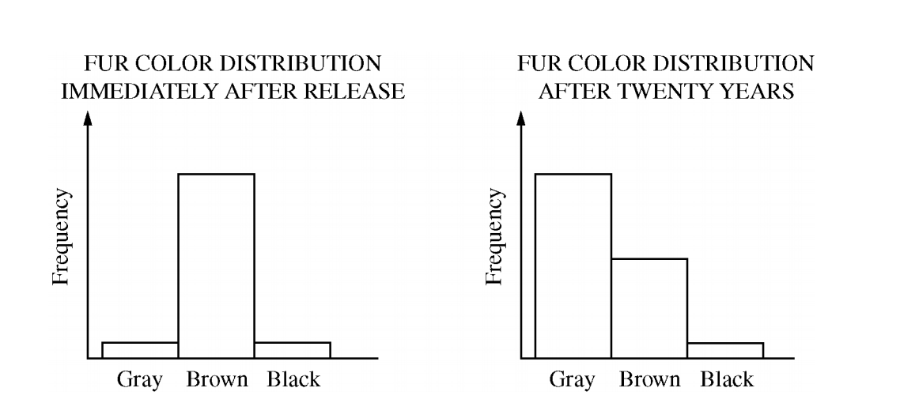
A group of mice was released into a large field to which no other
mice had access. Immediately after the release, a representative
sample of the mice was captured, and the fur color of each individual
in the sample was observed and recorded. The mice were then returned
to the field. After twenty years, another representative sample of the
mice was captured, and the fur color of each individual in the sample
was again recorded. Which of the following best explains the change in
the frequency distribution of fur color phenotypes in the mouse
population, as shown in the figures above?
A) The allele for gray
fur color is unstable, and over twenty years most of those alleles
mutated to become
alleles for black fur.
B) The field was
composed primarily of light-colored soil and little vegetation,
affording gray mice protection from predators.
C) Sexual
selection led to increased mating frequency of black and brown versus
gray and brown.
D) The gray mice were hardest to capture and so
were underrepresented in the twenty-year sample.
B
Ellis-van Creveld syndrome is a recessive genetic disorder that
includes the characteristics of short stature and extra fingers or
toes. In the general population, this syndrome occurs in approximately
1 in 150,000 live births. In a particular isolated population,
however, the incidence of this syndrome among live births is 1 in
500.
Assume that both the isolated population and the
general population are in Hardy-Weinberg equilibrium with respect to
this syndrome. Which of the following best describes the difference
between the frequency of the allele that causes the syndrome in the
general population and the frequency of the allele in the isolated
population?
A. The frequency of the Ellis-van Creveld
allele is 0.002 in the isolated population and 0.0000066 in the
general population,which suggests that selection for this trait is
occurring in both populations.
B. The frequency of the Ellis-van
Creveld allele is 0.0447 in the isolated population and 0.0026 in the
general population, showing that the rate of genetic mutation is
highest among individuals in the isolated population.
C. The
frequency of the Ellis-van Creveld allele is 0.002 in the isolated
population and 0.0000066 in the general population, which demonstrates
gametic incompatibility between the populations.
D. The frequency
of the Ellis-van Creveld allele is 0.0447 in the isolated population
and 0.0026 in the general population, which suggests that genetic
drift has occurred in the isolated population.D. The frequency of the
Ellis-van Creveld allele is 0.0447 in the isolated population and
0.0026 in the general population, which suggests that genetic drift
has occurred in the isolated population.
D
The higher the proportion of loci that are "fixed" in a
population, the lower is that population's
A) nucleotide
variability only.
B) genetic polyploidy only.
C) average
heterozygosity only.
D) nucleotide variability, average
heterozygosity, and genetic polyploidy.
E) nucleotide variability
and average heterozygosity only.
E
Which statement about variation is true?
A) All phenotypic
variation is the result of genotypic variation.
B) All genetic
variation produces phenotypic variation.
C) All nucleotide
variability results in neutral variation.
D) All new alleles are
the result of nucleotide variability.
E) All geographic variation
results from the existence of clines.
D
When we say that an individual organism has a greater fitness than another individual, we specifically mean that the organism
A. lives longer than others of its species
B. competes for resources more successfully than others of its species
C. mates more frequently than others of its species
D. utilizes resources more efficiently than other species occupying similar niches
E. leaves more viable offspring than others of its species
E
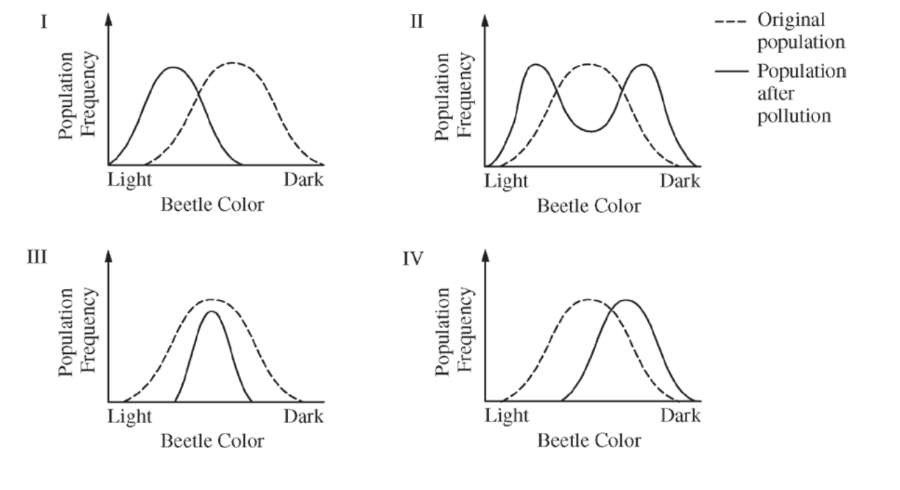
In a hypothetical population of beetles, there is a wide variety of color, matching the range of coloration of the tree trunks on which the beetles hide from predators. The graphs below illustrate four possible changes to the beetle population as a result of a change in the environment due to pollution that darkened the tree trunks. Which of the following includes the most likely change in the coloration of the beetle population after pollution and a correct rationale for the change?
(A) The coloration range shifted toward more light-colored beetles, as in diagram I. The pollution helped the predators find the darkened tree trunks.
(B) The coloration in the population split into two extremes, as in diagram II. Both the lighter-colored and the darker-colored beetles were able to hide on the darker tree trunks.
(C) The coloration range became narrower, as in diagram III. The predators selected beetles at the color extremes.
(D) The coloration in the population shifted toward more darker-colored beetles, as in diagram IV. The lightercolored beetles were found more easily by the predators than were the darker-colored beetles.
D
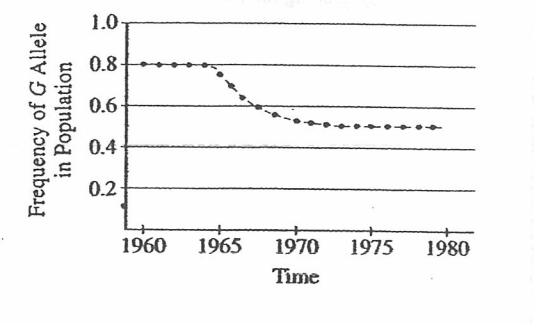
A moth's color is controlled by two alleles, G and g, at a single locus. G (gray) is dominant to g (white). A large population of moths was studied, and the frequency of the G allele in the population over time was documented, as shown in the figure below. In 1980, a random sample of 2,000 pupae was collected and moths were allowed to emerge.
During which of the following time periods could the population have been in Harvey Weinburg equilibrium for the G locus?
I. 1960-1964
II. 1965-1972
III. 1973-1980
a. I only
B. II only
C. III only
D. I and III only
E. I, II, and III
D

A moth's color is controlled by two alleles, G and g, at a single locus. G (gray) is dominant to g (white). A large population of moths was studied, and the frequency of the G allele in the population over time was documented, as shown in the figure below. In 1980, a random sample of 2,000 pupae was collected and moths were allowed to emerge.
Assuming that the population was in Hardy-Weinberg equilibrium for the G locus, what percentage of moths in the natural population was white in 1962?
a. 2%
B. 4%
C. 8%
d. 20%
e. 64%
B

A moth's color is controlled by two alleles, G and g, at a single locus. G (gray) is dominant to g (white). A large population of moths was studied, and the frequency of the G allele in the population over time was documented, as shown in the figure below. In 1980, a random sample of 2,000 pupae was collected and moths were allowed to emerge.
Assuming that the population was in Hardy-Weinberg equilibrium for the G locus, what percentage of the gray moths that emerged in 1980 was heterozygous?
a. 0.33
b, 0.5
c. 0.6
d. 0.75
e. 1.0
B 0.5

A moth's color is controlled by two alleles, G and g, at a single locus. G (gray) is dominant to g (white). A large population of moths was studied, and the frequency of the G allele in the population over time was documented, as shown in the figure below. In 1980, a random sample of 2,000 pupae was collected and moths were allowed to emerge.
Which of the following is the most likely reason for the observed differences in the frequency of the G allele between 1965 and 1972?
a. emigration of white moths from the population
b. chance
c. selection against gray phenotypes
d. speciation
e. mutation
C
In a certain group of rabbits, the presence of yellow fur is the
result of a homozygous recessive condition in the biochemical pathway
producing hair pigment. If the frequency of the allele for this
condition is 0.1, which of the following is closest to the frequency
of the dominant allele in this population? (Assume that the population
is in Hardy-Weinberg equilibrium.)
A. 0.01
B. 0.20
C.
0.40
D. 0.90
E. 0.10
D
In parts of Africa where Malaria is prevalent, individuals who are
heterozygous for sickle cell disease are at an advantage. This, as
well as other examples of heterozygote advantage, should be most
closely linked to which of the following?
A. Sexual
selection
B. Stabilizing selection
C. Disruptive
selection
D. Directional selection
B. Stabilizing selection
The wing of a bat, the flipper of a whale, and the forelimb of a
horse appear very different, yet detailed studies reveal the presence
of the same basic bone pattern. These structures are examples ofA.
Analogous structures.
B. Homologous structures.
C. Vestigial
structures.
D. Balanced polymorphism.
E. Convergent evolution.
B
Although the seal and the penguin both have streamlined, fishlike
bodies with a layer of insulating fat, they are not closely related.
This similarity results from
(A) convergent evolution
(B)
adaptiveradiation
(C) homologous evolution
(D)
coevolution
(E) parallel evolution
A
which of the following is probably the best explanation for the fact
that Antarctic penguins cant fly, although there is evidence that
millions of years ago their ancestors could do so?
A. penguins
live on land and feed in the water, therefore they have no need to
fly
B. the antarctic home of penguins is flat and barren, so
there's no place to fly
C. ancestral penguins without large wings
were better able to swim and feed in water, so they passed their genes
for shorter wing structure to their offspring
D. ancestral
penguins didnt use their wings for long periods of time, so todays
penguins have tiny nonfunctional wings
C
The external similarity of dolphins to sharks is an example
of
(A) convergent evolution
(B) divergent evolution
(C)
behavioral isolation
(D) geographic isolation
(E) adaptive radiation
A
The FtsZ protein is present in prokaryotes and in
chloroplasts.
The protein is structurally and
functionally similar to tubulin
proteins of
eukaryotic cells. Which of the following is
a
likely conclusion to draw from this information?
(A) FtsZ
and tubulin proteins were both present
in a common
ancestor.
(B) Microtubules are involved in the mechanics
of
photosynthesis.
(C) Tubulin genes are evolutionarily
derived
from the gene that codes for the
FtsZ
protein.
(D) The sequences of the genes encoding the
FtsZ
and tubulin proteins are identical.
C
Many species of animals are indigenous to caves. Which of the following structures would be MOST likely to have become vestigial in these organisms?
a. eyes
b. ears
c. teeth
d. legs
e. tail
eyes
Which of the following is the unit of evolution? In other words, which of the following can evolve in the Darwinian sense
a. gene
b. chromosome
c. individual
d. population
e. species
D
The Darwinian fitness of an individual is measured most directly by
?
a. the number of mates it attracts.
b. the
number of "good genes" it possesses.
c. the
number of its offspring that survive to reproduce.
d.
its physical strength.
e. how long it lives
C
A biologist spent many years researching the rate of evolutionary change in the finch populations of a group of islands. It was determined that the average beak size (both length and mass) of finches in a certain population increased dramatically during an intense drought between 1981 and 1987. During the drought, there was a reduction in the number of plants producing thin-walled seeds.
Which of the following procedures was most likely followed to
determine the change in beak size?
(A) A few finches were trapped
in 1981 and again in 1987, and their beak sizes were
compared.
(B) The beak size in fifteen finches was measured in
1987, and the beak size in the original finches was determined by
estimation.
(C) The beak size in a large number of finches was
measured every year from 1981 to 1987.
(D) Finches were captured
and bred in 1981, and the beak size of the offspring was measured.
C
A biologist spent many years researching the rate of evolutionary change in the finch populations of a group of islands. It was determined that the average beak size (both length and mass) of finches in a certain population increased dramatically during an intense drought between 1981 and 1987. During the drought, there was a reduction in the number of plants producing thin-walled seeds.
Which of the following statements might best explain the increase in
average beak size in the finch population during the drought?
(A)
Finches with bigger beaks are better able to crack thick-walled seeds
and produce more surviving offspring.
(B) Finches with bigger
beaks can attack and kill finches with smaller beaks.
(C) Finches
with bigger beaks possess more- powerful flight muscles and are able
to find more food.
(D) Finches that crack large seeds develop
larger beaks over time....
A
A biologist spent many years researching the rate of evolutionary change in the finch populations of a group of islands. It was determined that the average beak size (both length and mass) of finches in a certain population increased dramatically during an intense drought between 1981 and 1987. During the drought, there was a reduction in the number of plants producing thin-walled seeds.
Which of the following best describes the mechanism behind the
change in beak size in the finch population?
(A) The formation of
two new finch species from a single parent species
(B) A change
in gene frequencies in the finch population due to selective pressure
from the environmental change
(C) A new allele appearing in the
finch population as a result of mutation
(D) The achievement of
dynamic equilibrium in the finch population as a result of homeostasis
B
A biologist spent many years researching the rate of evolutionary change in the finch populations of a group of islands. It was determined that the average beak size (both length and mass) of finches in a certain population increased dramatically during an intense drought between 1981 and 1987. During the drought, there was a reduction in the number of plants producing thin-walled seeds.
The biologist discovered that from 1988 to 1993, the average
beak size declined to pre-1981 levels. The reversal in beak size from
1988 to 1993 was most likely related to which of the following
events?
(A) A loss of food supply for the finches
(B) The
end of the drought
(C) An increase in drought conditions
(D)
An increase in predators consuming finches
B
A. random selection
B. directional selection
C. stabilizing
selection
D. disruptive selection
E. sexual
selection
An African butterfly species exists in two strikingly
different color patterns.
D
A. random selection
B. directional selection
C. stabilizing
selection
D. disruptive selection
E. sexual
selection
Brightly colored peacocks mate more frequently than do
drab peacocks.
E
A. random selection
B. directional selection
C. stabilizing
selection
D. disruptive selection
E. sexual
selection
Most Swiss starlings produce four to five eggs in each clutch.
/c
A. random selection
B. directional selection
C. stabilizing
selection
D. disruptive selection
E. sexual
selection
Fossil evidence indicates that horses have gradually
increased in size over geologic time.
b
A. random selection
B. directional selection
C. stabilizing
selection
D. disruptive selection
E. sexual
selection
The average birth weight for human babies is about 3 kg.
/c
A. random selection
B. directional selection
C. stabilizing
selection
D. disruptive selection
E. sexual selection
A
certain species of land snail exists as either a cream color or a
solid brown color. Intermediate individuals are relatively rare.
d
A. random selection
B. directional selection
C. stabilizing
selection
D. disruptive selection
E. sexual
selection
Pathogenic bacteria found in many hospitals are
antibiotic resistant.
b
The allele that causes phenylketonuria (PKU) is harmful, except when
an infant's diet lacks the amino acid, phenylalanine. What maintains
the presence of this harmful allele in a population's gene pool?
A) heterozygote advantage
B) stabilizing selection
C) balanced polymorphism
D) diploidy
E) balancing selection
d
A change in the frequencies of alleles in the gene pool of a small population arising from chance events is called
a. gene flow
b. selection
c. genetic drift
d. mutation pressure
e. differential reproduction
c.
Which of the following statements best supports the claim that organisms share fundamental processes as a result of evolution? (A) All organisms that are introduced into new environments have the capacity to fill vacant ecological roles. (B) All organisms have the ability to utilize oxygen to harness energy from the chemical breakdown of organic compounds. (C) All organisms share a genetic code organized into triplet codons, making it possible for one organism to express a gene from another organism. (D) All organisms possess structures such as chloroplasts and mitochondria within their cells that reflect past symbiotic relationships between prokaryotic precursors.
C
The best evidence that the giant panda is more closely related to
bears than is the racoonlike lesser panda involves
A. comparative
anatomy
B. comparative embryology
C. DNA sequence
comparisons
D. behavioral similarities
E. fossil records
C
In a certain flock of sheep 4% of the population has black wool and 96% of the population has white wool. Assume that the population is in Hardy-Weinburg equilibrium. IF the black wool is a recessive train, what percentage of the population is heterozygous for the trait?
a. 4%
b. 20%
c. 32 %
d. 64%
e. 80%
C
In a certain flock of sheep 4% of the population has black wool and 96% of the population has white wool. Assume that the population is in Hardy-Weinburg equilibrium. What percentage of the population is homozygous for white wool?
a. 20%
b. 40%
c. 64%
d. 80%
e. 96%
c
In a certain flock of sheep, 4% of the population has black wool and 96% has white wool. Assume that the population is in Hardy-Weinberg equilibrium. If black wool is a recessive trait, what percentage of the population is heterozygous for this trait?
32%
In a certain flock of sheep, 4% of the population has black wool and 96% has white wool. Assume that the population is in Hardy-Weinberg equilibrium. What percentage of the population is homozygous for white wool?
64%
All of the following conditions would result in a change in the frequency of a specific allele in a population EXCEPT ____________.
A. selection against the recessive phenotype
Bselection against the dominant phenotype
C. genetic drift
D. random mating in a large population
E. mutation of the dominant allele to the recessive allele
D
Experimental evidence shows that the process
of glycolysis is
present and virtually identical
in organisms from all three
domains, Archaea,
Bacteria, and Eukarya. Which of the
following
hypotheses could be best supported by
this
evidence?
(A) All organisms carry out glycolysis
in
mitochondria.
(B) Glycolysis is a universal
energy-releasing
process and therefore suggests a
common
ancestor for all forms of life.
(C) Across the three
domains, all organisms
depend solely on the process of
anaerobic
respiration for ATP production.
(D) The presence
of glycolysis as an energyreleasing
process in all organisms
suggests
that convergent evolution occurred
B
All of the following statements concerning the theory of evolution by
natural selection are true EXCEPT:
A. Organisms produce far more
offspring than are required for replacement.
B. The individuals
in a population show variation in survivability and in their ability
to cope with environmental stress.
C. The number of offspring
that survive to reproduce varies among individuals.
D. The bodies
of organisms in a population change by use and disuse, and the changes
are inherited by the next generation.
E. Some of the variation in
adaptation is the result of genetic differences that may be passed on
to the next generation.
D. The bodies of organisms in a population change by use and disuse, and the changes are inherited by the next generation.
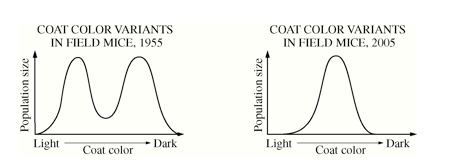
A research study sampled populations of field mice annually over the course of 50 years. The population was
categorized by coat color. Data from the beginning and end of the study are graphed above. What type of
selection is represented by the change in the data from 1955 to 2005 ?
(A) Directional selection
(B) Stabilizing selection
(C) Bimodal selection
(D) Disruptive selection
(E) Sexual selection
B
In evolutionary terms, which of the following organisms is the most
successful?
A. The one that lives the longest.
B. The one
that grows the most rapidly.
C. The one that leaves the greatest
number of offspring that reproduce.
D. The one that has the best
characteristics for the current environment.
E. The one that has
the biggest territory.
C
If a population is at Hardy-Weinberg equilibrium, which of the following can be predicted for the recessive alleles in the population?
1) They will eventually disappear,
2) They will be selected against,
3) They will be maintained at the same frequency,
4) They will be expressed in the heterozygous condition,
5) They will become dominant.
c
.The different species of finches on the Galapagos Islands are
believed to have arisen as a result of natural selection acting on
populations of finches that had experienced
A. Convergent
evolution
B. Gene flow
C. The bottleneck effect
D.
Geographic isolation
E. hybrid sterility
D
Toads in a particular population vary in size. A scientist
observes that in this population, large males mate with females
significantly more often than small males do. All the following are
plausible hypotheses to explain this observation EXCEPT:
(A)
Females select large males more often than they select small males
as mates.
(B) Small females are more likely to mate with small
males and large females are more likely to mate with large
males.
(C) Large males are successful in competing for mates
more often than small males are.
(D) Large males occupy more
breeding territory than small males do.
(E) The calls produced
by large males are more attractive to females than the calls made by
small males.
B
MRSA is an acronym for methicillin-resistant Staphylococcus aureus. Many of the strains of the common bacterium are also resistant to other antibiotics in use today. The resistance is linked to a collection of genes carried on plasmids that are passed from one bacterium to another by conjugation. Suppose a newly discovered, chemically different antibiotic is used in place of methicillin. Which of the following would be the most likely effect on Staphylococcus aureus antibiotic resistance?
A. The gene for methecillan resistance no long needed would disappear entirely from Staphyloccoccus aurus populations within a few generations
B. Transmission of the methicillin-resistance plasmid by conjugation would increase amont the Staphyloccocus aureus population as the genes would confer resistance to the new antibioltic
C. Transmission of the methicillin-resistance would gradually decrease but the plasmid would not entirely disappear from the Staphyloccoccus aureus population
D. Transmission of the methicillin-resistance
C
If, on average, 46% of the loci in a species' gene pool are
heterozygous, then the average homozygosity of the species should be.
A. 92%
B. 46%
C. 23%
D. 54%
E. not
enough info
D
Which of these is a statement that Darwin would have
rejected?
A) Environmental change plays a role in
evolution.
B) The smallest entity that can evolve is an
individual organism.
C) Individuals can acquire new
characteristics as they respond to new environments
or
situations.
D) Inherited variation in a population is a
necessary precondition for natural selection to
operate.
E)
Natural populations tend to produce more offspring than the
environment can
support.
B
Each of the following has a better chance of influencing gene
frequencies in small
populations than in large populations, but
which one most consistently requires a small
population as a
precondition for its occurrence?
A) Mutation
B) Non-random
mating
C) Genetic drift
D) Natural selection
E) Gene flow
C

The following questions refer to Figure 22.1, which shows an outcrop
of sedimentary rock whose strata are labeled AD.
38) If x indicates the location of fossils of two closely
related species, then fossils of their most-recent common ancestor are
most likely to occur in which stratum?
A) A
B) B
C)
C
D) D
/c

The following questions refer to Figure 22.1, which shows an outcrop
of sedimentary rock whose strata are labeled AD.
39) If x indicates the fossils of two closely related species,
neither of which is extinct, then their remains may be found in how
many of these strata?
A) one stratum
B) two strata
C) three strata
D) four strata
B

Which stratum should contain the greatest proportion of extinct organisms?
D
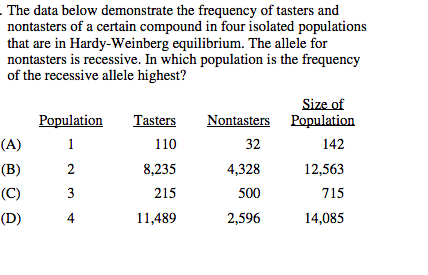
C
Two populations of species of quirrel are georgraphically isolated
from each other. Although they have the same population density, one
population is significantly larger in number than the other one. A new
bacterial disease, which is easily spread and extremely virulent,
affects both populations at the same time. Which of the following is
the best prediction of how the new disease will affect the two
populations.
A. The two populations will be equally affected,
because the ability to trigger an immune response is randomly
distrubted among all squirrrels of that species
B. The larger
population will be less affected by the disease than will the smaller
population, because the mutation rate of the larger population is
higher than the mutation rate of the smaller population
C. The
smaller population will be more affected than the larger population,
because the smaller population has less genetic variation than the
larger population has.
D. The smaller population will be less
affected than will the larger population, because the smaller
population exhibits more genetic drift than the larger population exhibitsC.
C
The gene pool can best be described as
a. total aggregate of genes in a population at any time
b. group of genes not described by the Hardy-Weinberg theorem
c. total number of gene loci that occur in each species
d. group of genes responsible for polygenic traits
C
From the fields of study listed below, choose the field that has provided each of the following pieces of evidence that biological evolution has occured:
a. comparitive anatomy
b. comparative biochemistry
c. paleontology
d. comparative embryology
e. geographical distribution
archaeopteryx is an extinct feathered reptile
C
From the fields of study listed below, choose the field that has provided each of the following pieces of evidence that biological evolution has occured:
a. comparitive anatomy
b. comparative biochemistry
c. paleontology
d. comparative embryology
e. geographical distribution
Peripatus has claws like an insect and paired nephridia like a segmented worm
A
From the fields of study listed below, choose the field that has provided each of the following pieces of evidence that biological evolution has occured:
a. comparitive anatomy
b. comparative biochemistry
c. paleontology
d. comparative embryology
e. geographical distribution
Most human diabetics can use insulin derived either from pigsof from humans
B
From the fields of study listed below, choose the field that has provided each of the following pieces of evidence that biological evolution has occured:
a. comparitive anatomy
b. comparative biochemistry
c. paleontology
d. comparative embryology
e. geographical distribution
During early development, a human fetus has tail and gill arches
D
Evolutionary biologists have observed variation in the average age and size of mature individuals in a population of small freshwater guppies. Guppies found in pools with pike cichlids— a predator fish that preys primarily on larger guppies—reproduce at a young age and are small at maturity. Guppies found in pools with killifish —a different predator fish that preys primarily on smaller guppies—reproduce at an older age and are larger at maturity. Which of the following predicts the most likely outcome of moving a population of guppies from a pool with pike cichlids to a pool with killifish?
(A) The introduced guppy population will remain phenotypically similar to the original population because the killifish will not recognize them as prey.
(B) Because the introduced population was in Hardy-Weinberg equilibrium, successive generations in the new population will continue to display the same allele frequencies as the original population.
(C) After many generations, the offspring of the introduced guppies will mature at an older age and larger size because of selective pressure from the new predator.
(D) Within two or three generations, the introduced guppies will become extinct because the killifish prefer the juveniles.
D
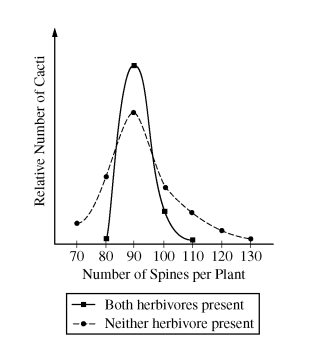
In a species of cactus, the number of spines on a plant is genetically determined. The graph above shows frequency distributions for populations of the cactus species growing in the presence or absence of two herbivores: peccaries (a New World pig) and wasp larvae. Which of the following best accounts for the different frequency distributions in the graph?
(A) Peccaries eat cacti with the greatest number of spines, and wasp larvae show no preference with respect to spine number.
(B) Peccaries eat cacti with a smaller number of spines, and wasp larvae eat cacti with a greater number of spines.
(C) Wasps have increasing difficulty depositing eggs on cacti with more spines, and peccaries show no preference with respect to spine number.
(D) Both peccaries and wasp larvae will eat the most abundant types of cacti, which are the plants with the greatest number of spines.
A
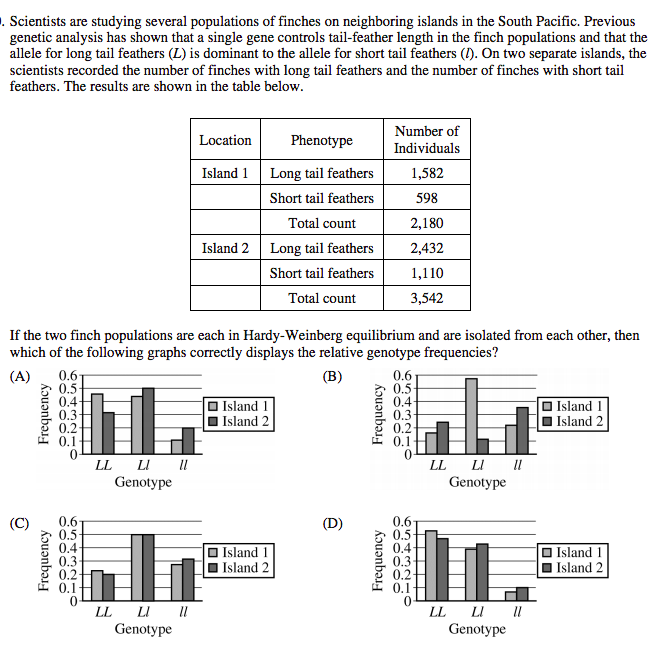
C
Experimental evidence shows that the process
of glycolysis is
present and virtually identical
in organisms from all three
domains, Archaea,
Bacteria, and Eukarya. Which of the
following
hypotheses could be best supported by
this
evidence?
(A) All organisms carry out glycolysis
in
mitochondria.
(B) Glycolysis is a universal
energy-releasing
process and therefore suggests a
common
ancestor for all forms of life.
(C) Across the three
domains, all organisms
depend solely on the process of
anaerobic
respiration for ATP production.
(D) The presence
of glycolysis as an energyreleasing
process in all organisms
suggests
that convergent evolution occurred.
A